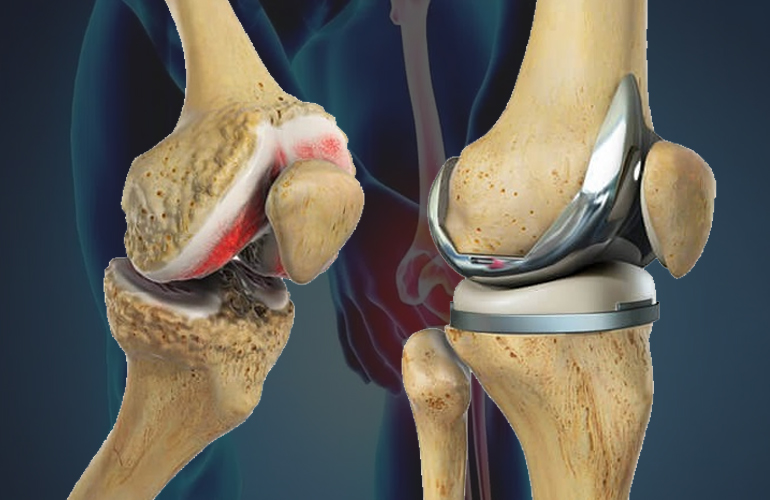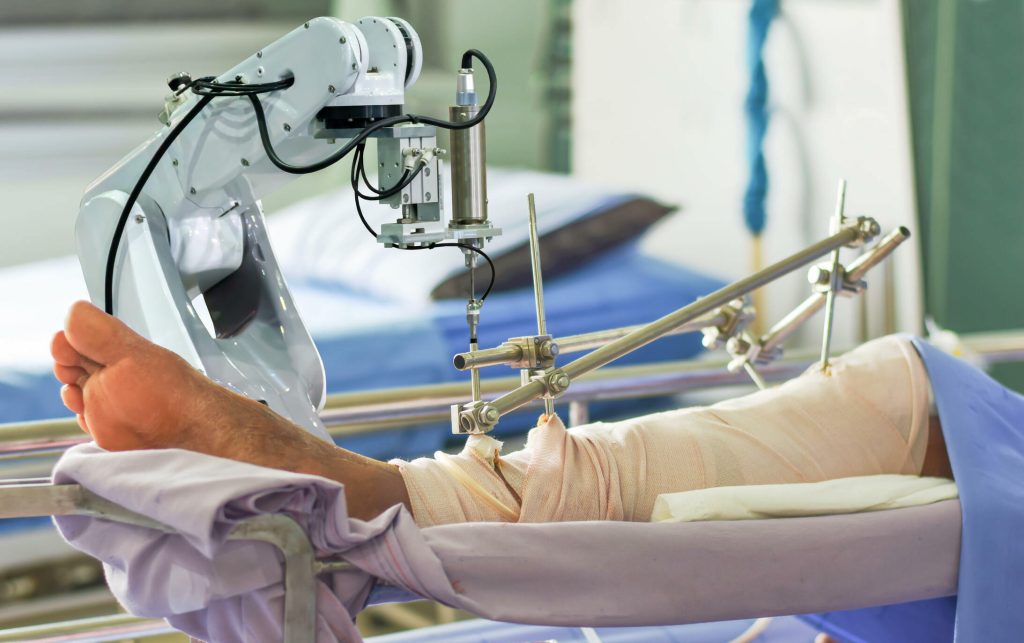Introduction
Knee replacement surgery has become a common procedure for people dealing with severe joint pain, limited mobility, or advanced arthritis. With advances in medical technology, patients today are presented with two main options—manual knee replacement and robotic-assisted knee replacement. Choosing the right one can make a big difference in recovery, comfort, and long-term success.
If you’re exploring these treatment options, this blog will walk you through the key differences, pros and cons of each method, and what to consider before making a decision. You’ll also learn how the choice of surgeon and technology can impact your outcome.
Understanding Manual Knee Replacement

Manual or traditional knee replacement is the time-tested surgical method that’s been performed for decades. In this approach:
- The surgeon uses hand-held tools and their experience to remove damaged bone and cartilage.
- A metal or plastic implant is placed to restore knee function.
- The alignment and positioning of the implant are judged manually using preoperative planning and intraoperative guides.
Advantages:
- Trusted and widely practiced.
- Lower upfront cost than robotic surgery.
- Experienced surgeons can achieve very good results.
Limitations:
- Precision depends on the surgeon’s skill and experience.
- Minor variations in alignment may occur.
- Recovery may take longer due to the invasive nature.
What Is Robotic Knee Replacement?
Robotic knee replacement uses a robotic arm system to assist the surgeon in performing the procedure with high precision. It involves:
- Pre-surgery 3D scans to map the knee joint.
- The robotic system helps guide the surgeon in removing bone and placing the implant.
- The robot doesn’t perform the surgery—it assists based on the surgeon’s inputs.
Benefits:
- Enhanced accuracy and alignment of the implant.
- Less soft tissue damage.
- Reduced pain and faster recovery.
- Lower risk of implant failure over time.
Challenges:
- Higher cost than manual surgery.
- Requires specialized training.
- Not every hospital is equipped with robotic systems.
Key Differences Between Manual and Robotic Knee Replacement
| Feature | Manual Surgery | Robotic Surgery |
| Precision | Depends on surgeon’s judgment | Computer-guided, highly precise |
| Recovery Time | May take longer | Often faster and less painful |
| Implant Longevity | Varies | Improved with accurate alignment |
| Learning Curve | Standard surgical training | Requires robotic system training |
| Cost | Lower | Higher due to technology |
When comparing the two, robotic-assisted surgery offers more consistent precision, which often results in better long-term outcomes. However, manual surgery still holds its ground when performed by a skilled orthopedic surgeon.
Which Option Is Right for You?
Choosing between manual and robotic knee replacement should be based on your specific condition, budget, and expectations.

You might prefer manual surgery if:
- Your surgeon has extensive experience in traditional methods.
- You’re looking for a cost-effective solution.
- Your knee anatomy is straightforward.
You might consider robotic surgery if:
- You want a more precise fit for your implant.
- You’re aiming for faster recovery and return to daily activities.
- Your knee has complex alignment issues or deformities.
Ask yourself:
- What matters more to me: cost or precision?
- Am I eligible for robotic surgery based on my medical history?
- Is the hospital equipped with the required technology?
Real-World Outcomes
Studies show that robotic knee replacements tend to offer better joint alignment, which can lead to reduced wear and longer implant life. Patients often report quicker pain relief and improved early function.
But successful outcomes also depend heavily on the surgeon’s experience. Even the most advanced robot won’t yield good results in inexperienced hands. That’s why choosing the right orthopedic surgeon is critical.
Recovery and Rehabilitation

Post-surgery recovery varies depending on the technique used and the patient’s overall health.
Manual surgery recovery:
- May involve more swelling and stiffness in the initial weeks.
- Typically needs longer physical therapy.
Robotic surgery recovery:
- Reduced trauma to soft tissue helps in faster healing.
- Patients often walk within a day and return home sooner.
Regardless of the technique, consistent rehabilitation is necessary for full recovery. Exercises, physiotherapy, and regular checkups remain essential.
Final Thought: It’s Not Just the Method, It’s the Expertise
Both manual and robotic surgeries can be effective. What makes the difference is the surgeon’s skill, patient education, and follow-up care. Speak openly with your doctor about your lifestyle, concerns, and treatment goals.
Dr. Kunal Makhija: Your Trusted Orthopedic Surgeon
Dr. Kunal Makhija’s approach is centered on providing personalized, patient-focused care. With a passion for improving the lives of his patients, he offers the best possible treatments backed by years of experience. If you’re looking for an expert in robotic knee replacement surgery and hip replacement surgery, Dr. Kunal Makhija is the surgeon you can trust for top-quality care and optimal results.
Contact Dr. Kunal Makhija for Consultation
To schedule a consultation with Dr. Kunal Makhija, or if you have any questions about robotic knee or hip joint replacement surgery, feel free to reach out. His clinic in Panvel, Navi Mumbai, is equipped with advanced technology to provide the best treatment options available.
Clinic Location:
Patel Clinic and Orthopaedic Centre,
Kuber Apartment ‘A’, Joshi Ali Road,
Near City Police Station, Panvel, Navi Mumbai – 410206.
Call Us:
+91 85913 99962
+91 87673 02801
Email:
[email protected]
Frequently Asked Questions (FAQs)
1. Is robotic knee replacement painful?
Most patients experience less pain with robotic surgery due to smaller incisions and less trauma to surrounding tissue.
2. How long does the robotic knee surgery take?
It usually takes around 1.5 to 2 hours. It’s slightly longer than manual surgery but offers greater precision.
3. What is the recovery time after robotic surgery?
Many patients can resume basic activities within 2 to 3 weeks, though complete recovery may take 6 to 8 weeks.
4. Is robotic surgery safe for elderly patients?
Yes, it’s safe and often beneficial due to faster recovery and reduced complications, provided the patient is medically fit.
5. How long does a knee implant last?
With robotic precision, implants can last 20 years or more. Proper care and follow-up help maintain joint function.
6. Are both knees done at the same time in robotic surgery?
This depends on the patient’s health. Some cases allow simultaneous surgery, while others require staged operations.
7. Is robotic surgery covered by insurance?
Some insurance providers cover robotic surgery, but it varies. It’s best to check with your insurance company directly.
8. Can I walk immediately after robotic knee replacement?
Most patients are encouraged to walk within 24 hours under supervision, which speeds up recovery and reduces complications.
Conclusion
Choosing between manual and robotic knee replacement isn’t just about technology—it’s about what fits your needs best. Robotic surgery brings advanced precision and faster recovery, while manual surgery remains a trusted method with proven success.
If you’re considering knee replacement, consult with an expert like Dr. Kunal Makhija to explore your options and get a treatment plan tailored to your health and lifestyle. Making an informed choice today can lead to a more active and pain-free tomorrow.
